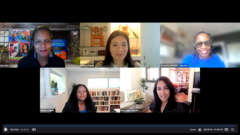The pandemic has exposed the hidden rules of our economy and education systems. Our current laws, policies, regulations, normative practices and narratives establish a racial and gender hierarchy of opportunity, ensuring Latinx and Black women are funneled into the lowest paying jobs with few employer benefits. Currently, 90% of occupations are racially segregated in the US, with race and gender being perhaps the most predominant indicators of the type of job someone can land. Research shows that employers pay men at a higher rate more in occupations that are dominated by men regardless of skill or education level. In sharp contrast, employers pay women less in occupations held primarily by women. As the rate of women working in a given occupation increases, their pay declines—even when controlling for education and skills.
In California, this means that the median annual wage among the most common jobs for Latinx women is only $27,000. Black women in California are more likely than any other group to struggle economically at all education levels. Occupational segregation has long-term impacts on the economic security and mobility of not only Black & Latinx women but also the financial well-being of their families.
On September 15, 2021 BA AFN held a funder conversation to better understand:
- The current context around occupational segregation
- Why it is an important framework to incorporate in our drive for economic justice
- The connection between occupational segregation and wealth disparities; and
- Where funders and economic justice advocates should focus their efforts to address key drivers and support solutions
SPEAKERS:
Rebecca Dixon, National Employment Law Project (NELP)
Zoë Polk, East Bay Community Law Center (EBCLW)
Anne Price, Insight Center for Community Economic Development
Rebeca Rangel, Y&H Soda Foundation (moderator)
READ THEIR BIOS
RESOURCES:
- Racism and the Economy Focus on Employment, by Rebecca Dixon
-
The Insight Center for Community Economic Development: Still Running Up the Down Escalator, Centering Blackness Framework and Mississippi is America
-
Occupational Segregation, Stanford Center on Poverty & Inequality.
-
Advancing Workforce Equity in the Bay Area: A Blueprint for Action by Policy Link + ReWork the Bay
-
Fines and Fees, a new case study out on the SF Financial Justice Project
-
VIDEO: Zoe Polk, Rebecca Dixon and others reflect on Juneteenth and discuss how we can collectively build and transform institutions to advance Black liberation.
AFN BRIEF
Unlocking Assets: Building Women’s Wealth Through Business Ownership
Presented in partnership with:





